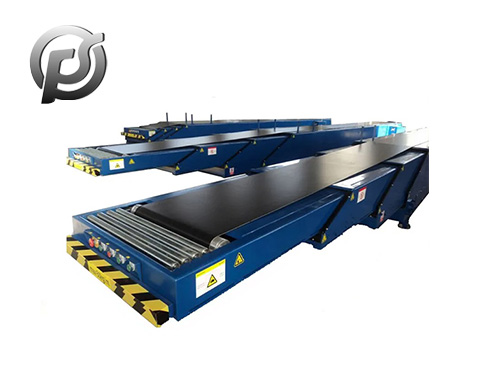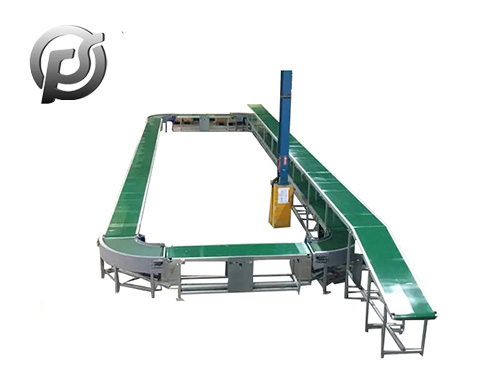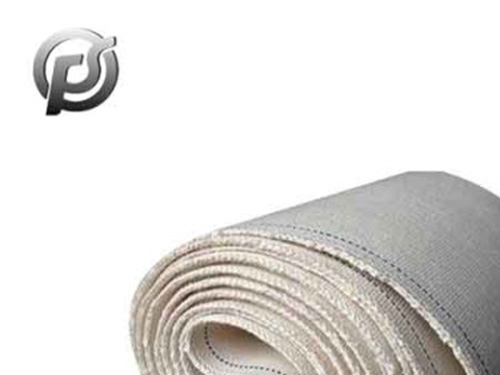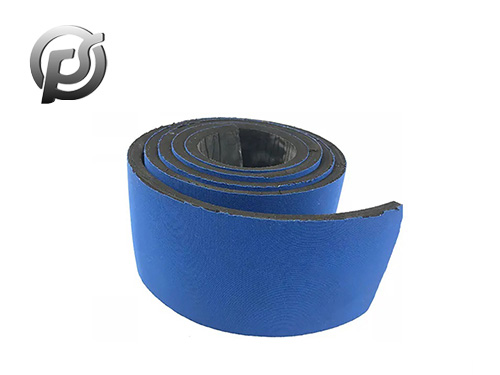The main reason for the replacement of conveyor belt is wear, wear is generally divided into the following three forms:
1) The wear at the vulcanization joint of conveyor belt is usually due to the high wear-resistance or hot vulcanization quality of the conveyor belt's own material than that of the rubber layer at the vulcanization joint, resulting in local wear of the rubber layer of the vulcanization joint, exposing the steel wire core or nylon core, which poses a serious threat to the strength of the vulcanization joint between the conveyor belt.
2) The conveyor belt is worn on the skirt plate
Improper adjustment of the skirt plate of conveyor belt guide device or poor design of the skirt plate will cause the skirt plate to wear the conveyor belt during operation, resulting in serious wear of the rubber layer on both sides of the conveyor belt. The steel rope core or nylon core is exposed in the longitudinal running direction of the whole belt. Once the steel rope core is warped, it is easy to wind on the idler, resulting in wire strip stripping or belt tearing.
3) The wear in the middle part of the conveyor belt is caused by the blanking impact. Because the blanking point of the funnel is relatively fixed, the wear of the part bearing the impact is intensified, resulting in serious local wear of the conveyor belt along the running direction, and also leading to the stripping of the exposed steel rope core or tearing of the conveyor belt. For nylon belt, the strength of the middle part will decrease due to the existence of 3 bearing rollers. ~ 4. As a result, the dangerous phenomenon of "tape overlap" will occur during the operation of belt under the action of the centriothrust force of the bearing roller.
2. Processing method of conveyor belt wear
The above wear forms pose a serious threat to the normal operation of the conveyor, but only because of the reduction of local strength or local wear of the conveyor belt to replace it, the operation cost will be greatly increased, therefore, in the actual operation, the following measures are adopted for local maintenance.
1) Local hot vulcanization technology The vulcanization machine is used for hot vulcanization. For the parts of the joint that are locally worn, the hot vulcanization technology can restore the performance of the conveyor belt, and the effect is better. The disadvantage is that manpower and material resources investment is large, and the time is long. It is suitable for local treatment of less than the surface area of vulcanized plate, and it is very difficult to deal with large area wear.
2) After grinding the worn parts with local cold vulcanization technology, the cold vulcanization glue is evenly applied to the worn surface after being mixed in proportion. Basically, the performance of the conveyor belt can be restored. But the curing time is long, curing at room temperature about 10 ~ 24h, the surface treatment is not smooth, after the cleaner is put in, the cleaning effect is not good.
3) Local cold bonding technology
Generally, repair strips (longitudinal cracks) made by German Tiptopo Company are used. The advantages are less manpower and material input, better wear resistance and reinforcement performance, short recovery time; The disadvantage is that it has high requirements on the environment, can not be restored to the original conveyor belt surface leveling requirements, and the cleaning effect of the cleaner is not good. However, for the equipment with high utilization rate, the popularization and application of cold bonding technology can effectively relieve the pressure caused by the limitation of vulcanization technology.
4) Spraying repair technology
Spraying polyurea elastomer (PUZPUA) with special equipment is a new solvent free and pollution-free green construction technology. This technology mixes two kinds of liquid materials by special equipment, and then sprays them into the worn surface of the conveyor belt under high pressure. According to the required thickness, a wear-resistant layer is formed, which is suitable for the local wear of connected pieces and can achieve good results. The advantages are:
① Fast curing, 5s gel, no flow hanging phenomenon, 1min can reach the walking strength;
② The thickness range of construction can be from hundreds of m to several em;
③ Excellent physical and chemical properties, such as tensile strength, elongation, flexibility, wear resistance, aging resistance, corrosion resistance, etc.;
(4) The formula system is adjustable, feel from soft rubber (Shao A30) to hard elastomer (Shao D65);
⑤ Convenient construction, high efficiency. The disadvantage is the need for special equipment, the use of external repair, coordination is difficult.
3. Comparison of cost and use effect. Comparison of cost per unit area and use effect of various treatment methods.
From the simple cost analysis, among the four local wear treatment methods, spraying treatment has a good performance, should be the best choice. Although the initial use effect of the cleaner is not good, but with the passage of time, the spraying surface is gradually smooth because of running-in, and the cleaning effect will be further improved. Because the conveyor belt wear is only part of the longitudinal wear, the steel rope or nylon core remains intact, so the strength is not significantly reduced, and the local glue is completely able to restore its performance.
Calculated with the spraying width of 0.5m and the thickness of 3mm, the cost of conveying belt spraying restoration is only 1/3.3 ~ 1/4.4 of the replacement of the new belt, which has a great advantage in price. Statistical comparison of the service life between the new belt and the spraying shows that the average service life after spraying is more than 1/2 of the original belt life. Combined with the above cost comparison, it is concluded that spraying technology has higher cost performance.
4. As can be seen from the above comparison, the spraying technology of local wear of conveyor belt has high promotion and application value.
Conveyor belt wear is not uniform damage to the whole. In many cases, it is the local longitudinal wear of the upper rubber layer in the belt section, while the upper rubber layer in other parts has a normal structure, and the overall framework of the conveyor belt is good. For such a conveyor belt, local spraying recovery is more advantageous to reduce costs. And the higher the cost of the new belt (such as the conveyor belt with larger bandwidth, the general spraying cost is only 1/4 of the cost of the new conveyor belt, but the life of the new conveyor belt 1/2), the higher the cost performance ratio. Therefore, spraying can not only reduce the one-time investment cost of conveyor belt, but also save a huge amount of money due to the interest loss caused by time. In addition, the conveyor belt can not be infinite spraying, with the extension of service life, there are also internal wire broken and other hidden dangers, still need to replace the conveyor belt according to the specific situation.
 Custom Conveyor Belts: Enhancing Efficiency and Productivity
Custom Conveyor Belts: Enhancing Efficiency and Productivity
 Stone Belt Conveyor: Efficient Material Handling Solution for Mining and Construction
Stone Belt Conveyor: Efficient Material Handling Solution for Mining and Construction
 Exploring the Dynamics of Conveyor Belt Manufacturing in China
Exploring the Dynamics of Conveyor Belt Manufacturing in China
 PE Conveyor Belts: Characteristics, Applications, and Advantages
PE Conveyor Belts: Characteristics, Applications, and Advantages